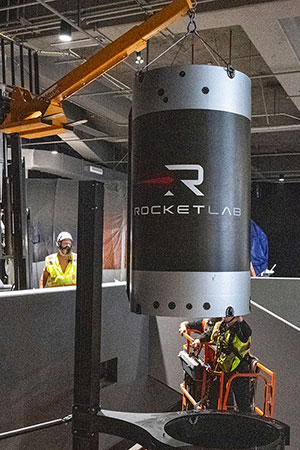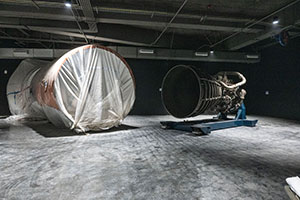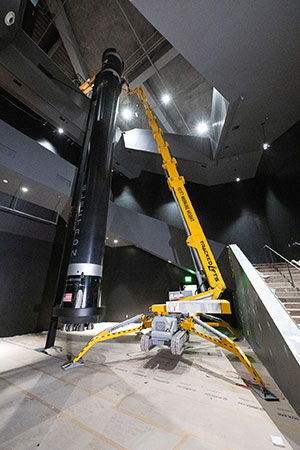November 18, 2025 — It took the California Science Center more than three years to erect its new Samuel Oschin Air and Space Center, including stacking NASA's space shuttle Endeavour for its launch pad-like display.
Now the big work begins.
"That's completing the artifact installation and then installing the exhibits," said Jeffrey Rudolph, president and CEO of the California Science Center in Los Angeles, in an interview with collectSPACE. "Most of the exhibits are in fabrication in shops around the country and audio-visual production is underway. We're full-on focused on exhibits now."
On Tuesday (Nov. 18), the science center is marking the addition of the first artifacts to the Kent Kresa Space Gallery. Named for the former chairman and CEO of Northrop Grumman and former chairman of General Motors, the gallery when completed will complement the Samuel Oschin Shuttle Gallery (featuring Endeavour) with three areas devoted to the themes of "Rocket Science," "Robots in Space" and "Humans in Space."
Now in place are a space shuttle main engine (SSME), a walkthrough segment of a shuttle solid rocket booster and a Rocket Lab Electron rocket.
"The biggest thing we have put in — other than the space shuttle — was the Electron, which we think is really significant," said Rudolph. "We're really happy to show next-generation technologies from startup companies with new launch vehicles, particularly if the company is based in California. Our goal is to inspire and motivate the next generation, and we think that showing folks that there are still a lot of innovative things going on, happening in their backyard, is a really great opportunity to inspire kids and people of all ages."
Founded in New Zealand in 2006 and now based in Long Beach, Rocket Lab developed the Electron as the first carbon-composite launch vehicle intended to service the small satellite market. It was also the first orbital-class rocket to use electric-pump-fed engines. Having now flown 75 successful missions (including five suborbital flights), the Electron is the third most launched small-lift rocket in history.
Of course, "small" can be relative. At 59 feet tall (18 meters), one floor of the Kresa gallery was not enough.
"The Electron rocket is actually at the center of a staircase, a section which is open all the way from level two, where you enter, to the lower level, which is 25 feet (7.6 meters) below. The Electron is standing up in that opening and it pretty much fills the whole thing," said Rudolph.
The SSME and solid rocket segment are located on the second floor in the section devoted to "Rocket Science" about how we get things off the planet.
Other space artifacts moving over from the California Science Center's main building or the former Samuel Oschin Endeavour Display Pavilion include NASA's Mercury-Redstone 2 (MR-2) capsule, the Gemini 11 spacecraft and the Apollo-Soyuz Test Project (ASTP) command module. There is also a SpaceX Dragon cargo capsule that resupplied the International Space Station three times and a Spacehab logistics module that flew aboard the shuttle Endeavour.
"We'll be adding a number of other spacecraft to that," Rudolph told collectSPACE. "Most of those are mockups or engineering models, because most of time, once we send something into space, we don't get it back to put into a museum."
In addition to the space artifacts, there are also about 100 exhibits to be added, which will add context to the spacecraft and other hardware visitors will see.
The same can be said for the Korean Air Aviation Gallery, which will showcase 20 aircraft in three areas: "Learning to Fly," "Everyday Flight" and "Advanced Aviation." The first to be installed, a Hawker Siddeley Harrier T.4 jet-powered strike aircraft, landed in that latter section in September.
Probably the most-anticipated artifact, the space shuttle Endeavour, is purposely being kept out of sight.
"The solid rocket boosters and external tank are pretty much unwrapped," said Rudolph, referring to the protective covering and scaffolding that surrounded the components during their stacking in early 2024. "Endeavour remains wrapped. The contractor is still doing a little bit of finishing work and so we're waiting until it's all done before we take away the protection."
"After they finish all of the work above and around the shuttle, we will then take off the protection and open one of the payload bay doors so you will be able to look inside. We then have to build out a little more of the platforms that will get you close access to the orbiter," Rudolph said.
Despite, or maybe because of all of the work still to be done, an opening date for the Samuel Oschin Air and Space Center has yet to be set.
"We'll announce the date for the opening when we know we'll be ready to open," said Rudolph. "When are ready, though, everyone will know." |
|

Workers install the upper stage of a Rocket Lab Electron in the new Kent Kresa Space Gallery, a section of the California Science Center's Oschin Air and Space Center. (California Science Center)

A walkthrough solid rocket booster segment and a space shuttle main engine were the first artifacts installed in the "Rocket Science" section of the new Kent Kresa Space Gallery in the Samuel Oschin Air and Space Center. (California Science Center)

The Rocket Lab Electron small-lift launch vehicle almost spans the three floors of the Kent Kresa Space Gallery in the Samuel Oschin Air and Space Center. (California Science Center) |
